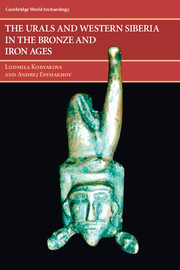Book contents
- Frontmatter
- Contents
- List of Plates, Figures, and Tables
- Foreword, by Philip L. Kohl
- Preface
- Introduction
- PART ONE THE BRONZE AGE: THE RISE OF ECONOMIC AND CULTURAL COMPLEXITY
- PART TWO THE IRON AGE – FORMING EURASIAN INTERACTIONS
- 5 The Transition to the Iron Age and New Tendencies in Economic Development
- 6 The Southern Urals within the Nomadic World: at the Cultural Crossroads
- 7 The World of Cultures of Cis-Urals Forest Zone of Eastern Europe: the Maintenance of Cultural Identities
- 8 The Forest-Steppe Cultures of the Urals and Western Siberia: on the Northern Periphery of the Nomadic World
- 9 Social Trends in North-Central Eurasia During the Second and First Millennia bc
- Notes
- References
- Index
7 - The World of Cultures of Cis-Urals Forest Zone of Eastern Europe: the Maintenance of Cultural Identities
from PART TWO - THE IRON AGE – FORMING EURASIAN INTERACTIONS
Published online by Cambridge University Press: 03 February 2010
- Frontmatter
- Contents
- List of Plates, Figures, and Tables
- Foreword, by Philip L. Kohl
- Preface
- Introduction
- PART ONE THE BRONZE AGE: THE RISE OF ECONOMIC AND CULTURAL COMPLEXITY
- PART TWO THE IRON AGE – FORMING EURASIAN INTERACTIONS
- 5 The Transition to the Iron Age and New Tendencies in Economic Development
- 6 The Southern Urals within the Nomadic World: at the Cultural Crossroads
- 7 The World of Cultures of Cis-Urals Forest Zone of Eastern Europe: the Maintenance of Cultural Identities
- 8 The Forest-Steppe Cultures of the Urals and Western Siberia: on the Northern Periphery of the Nomadic World
- 9 Social Trends in North-Central Eurasia During the Second and First Millennia bc
- Notes
- References
- Index
Summary
This world is composed of various cultures that have continued the basic traditions of the local Bronze Age. The most significant among them are two cultural formations that gave their names to the early (eighth to third centuries bc), and later (second century bc to second century ad) phases of the local Iron Age. These are the Ananyino and the Pyanobor intercommunities, the sites of which are concentrated mainly along the Kama basin (left tributary of the Volga river). Gening (1988) defines this area as the Prikamsky historical and geographical region where the continuous development of economic, social, and cultural processes resulted in the formation of ethnic groups of the western Urals such as: the Komi-Permians, the Udmurts (Votyaks), the Cheremis (Mari), and Mordvins (Goldina 1999; Khalikov 1990). Some Scandinavian scholars regard the northern Fennoscandia as the westernmost component of this world. During the eighth–seventh centuries bc and continuing from that time, the economic and cultural changes that occurred in northern Fenno-Scandia were mainly related to links with the Ananyino culture metallurgical centers (Aronsson & Hedman 2000). Northeastern Europe constituted its part as well.
There has been more then a century of archaeological study of Kama area of the Cis-Urals. In the 1858, the local official Alabin excavated forty-eight graves in the cemetery near the Ananyino village located on the Vyatka River. He collected a large number of bronze artifacts: weaponry, female decorations, implements, and stone anthropomorphic figurines (Alabin 1859; 1860).
- Type
- Chapter
- Information
- The Urals and Western Siberia in the Bronze and Iron Ages , pp. 251 - 276Publisher: Cambridge University PressPrint publication year: 2007



